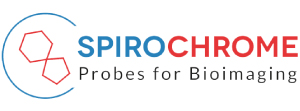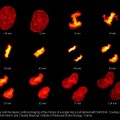Nuclear DNA staining (fluorescent probe) for FACs, high content screening, live cell studies and chromosome tracking
There are several classes of DNA fluorescence probes such as ethidium bromide, Dapi, Hoechst™ and far-red dyes such as SiR-DNA™, Syto61™, DRAQ5™ or Vybrant® DyeCycle™ Ruby. Currently among the DNA stains that work on live cells, there are two groups. The first is the Hoechst series which are cell permeable and fluorogenic (i.e. low fluorescence until binding target DNA), but they are quite toxic due to the requirement for short UV-blue wavelength excitation in the 340-360 nm range.

The second group of live cell dyes consists of far-red dyes such as SiR-DNA™, Syto61™, DRAQ5™ or Vybrant® DyeCycle™ Ruby. These dyes overcome the limitations arising from the spectral range of the previous group and permit the use of low energy excitation light with a wavelength of around 650 nm and emit around 700 nm. This light is minimally phototoxic (as for SiR-tubulin™ and SiR-actin™) and cells or tissue samples do not absorb light or emit autofluorescence in this range of the spectrum. This makes it possible to image deeper sections in thick samples.
In contrast, Dapi and Ethidium bromide are not cell permeable and one of short these also requires short UV wavelength excitation (Dapi) and the other is wavelength blue light in the range of 350 nm is very energetic and can cause photo-damage (oxidation) to live cells if they are imaged for more than 1-10 min. In addition, in this spectral range, tissues and cells have a high absorbance and autofluorescence. It is therefore very difficult to image deep within tissue samples. Finally, these dyes are not very well suited for superresolution due to the limitation of time of cell exposure to excitation light. mutagenic (Ethidium bromide).
SiR-DNA™ (Spirochrome SA) has further advantages over the far-red group of dyes. The problem with Syto61™, DRAQ5™ or Vybrant® DyeCycle™ Ruby dyes is that they either display a strong toxic effect on the cells at the concentrations the supplier recommends to use them (the cells stop to divide or die), whereas SiR-DNA can be used continuously over normal experimental time courses of 8 h, and probably much longer. The Syto61™, DRAQ5™
or Vybrant® DyeCycle™ Ruby dyes also create a strong non-specific signal on other structures than DNA in living cells. Syto 61 is compatible with superresolution microscopy but its high background fluorescence and its toxicity make it not an attractive choice. SiR-DNA signals remain strong with many exposures to excitation light, in tests of stability the dye retained 70% of its original intensity after 140 exposures / time point recordings.
The main advance of developing SiR-DNA™ is to combine the fluorogenic character, high DNA specificity and the low toxicity with the far-red excitation/emission range. In addition the probe performs extremely well with superresolution microscopy (STED and SIM) due to its stability and requirement for far-red light. Therefore, SiR-DNA is a superior probe with unmatched properties just as SiR-tubulin and SiR-actin.
In microscopy and high content screening, SiR-DNA™ allows facile nuclear counterstaining without UV excitation. In flow cytometry, SiR-DNA™ allows phenotyping of blood/BM and direct cellular DNA content analysis without any RBC lysis or fixation, permeabilization or RNase treatment.


To order SiR-DNA Spriochrome product via Cytoskeleton Inc, click here.
For more information on the SiR-DNA product from Spirochrome click this link.
SiR-DNA™ is a trademark of Spirochrome SA (Switzerland).
Vybrant® DyeCycle™ Ruby stain is a trademark of Thermo Fisher Scientific USA (Molecular Probes Inc.).
DRAQ5™ is a trademark of Biostatus Ltd.
Syto61™ is a trademark of Thermo Fisher Scientific USA (Molecular Probes Inc.).
Hoechst™ is a trademark of Sanofi USA.
